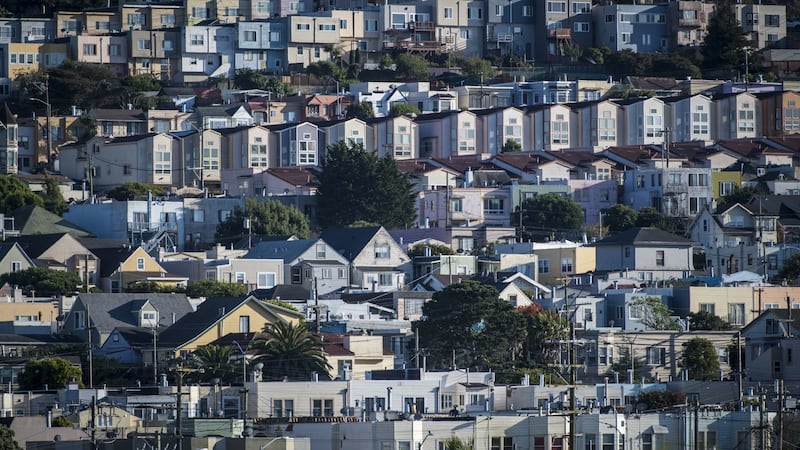Mike Reed's camper is parked on the side of the road alongside the boundary to Stanford University in Palo Alto, California, in the heart of Silicon Valley. To one side of his vehicle are the well-kept playing fields and tree-lined avenues of Stanford's campus. To the other, traffic whirs past along the six-lane El Camino Real.
This patch of roadside is home to Reed (53), and his camper is one in a long row of recreational vehicles, or RVs, that line El Camino Real, day and night. “I can save a lot more money living here on the street than anywhere else,” says Reed.
Reed, a plumber, is working on the construction of on-campus housing at Stanford. It was too expensive for him to rent a place in the area so he bought a camper instead. “I get paid really well but even being single I can’t afford a place around here,” says Reed. “If I had a family it would be really hard . . . I don’t know how people do it day-to-day.”
The number of homeless people in the Bay Area as a whole is estimated at 35,000
Reed's story is typical of many people across the San Francisco Bay Area, a nine-county region that includes San Francisco in the north and San Jose to the south. The area is home to the biggest companies in the tech industry – Google, Facebook, Apple, LinkedIn, Salesforce – as well as countless startups.
The region, with a population of 7.8 million, is the powerhouse of California’s economy, which is itself the fifth-largest economy in the world. But it is becoming increasingly difficult for lower- and middle-income workers to survive in the Bay Area, as rents and house prices soar to unprecedented levels amid surging high-wage job growth and a chronic lack of supply in housing, particularly affordable housing.
“It’s by far the most expensive area in the US,” says Cheryl Young, senior economist at Zillow real estate company.
According to Zillow, the median home value in the US is about $229,600 (€208,400), whereas in the San Francisco metropolitan area, the median home value is $934,700. In the San Jose metropolitan area, which includes Mountain View, home to Google, the figure is $1.14 million.
There has been a particularly steep escalation in home values in the Bay Area compared with the rest of the US over the past 10 years. In the US, home value growth from 2009 to 2019 rose 39.4 per cent, according to Zillow, but in the San Francisco area the home value growth was 80.9 per cent and in the San Jose area it was 99.9 per cent.
It’s not surprising then, that people on low and medium incomes are struggling, and the signs of that are everywhere. It’s hard to ignore the tents beneath overpasses in San Francisco, the people sleeping in doorways and begging on corners, the campers stationed along suburban roads, the parked cars with their back seats filled with sleeping bags, clothes, belongings.
San Francisco in numbers
7.8m Bay Area population
676,000 Jobs added since 2011
176,000 Housing units added since 2011
81% Home value growth since 2009
37% Rent value growth since 2010
$72k Average salary in San Francisco metro area
$114k Average tech salary
$201k Salary required to afford median-priced home
Sources: US Census Bureau; Wealth-X; 2019 point-in-time homeless counts; Bay Area Council; HSH.com; Business.org; Zillow
Rents have followed a similar trend, with rent value growth up 36.6 per cent in San Francisco and 48.4 per cent in San Jose since 2010. The median rent in the San Francisco area is now $3,169 a month, and in San Jose it’s $3,329.
Homelessness in the area is skyrocketing. In San Francisco, the number of homeless people increased by 17 per cent in the past two years, while in Santa Clara county, which includes San Jose, Mountain View and Palo Alto, it rose by 31 per cent. The number of homeless people in the Bay Area as a whole is estimated at 35,000.
“We’re losing ground, we’re pedalling as fast as we can,” says Brian Greenberg, vice-president of programmes and services at LifeMoves, a homelessness organisation based in the Bay Area.
According to the 2019 San Francisco Homeless Point-in-Time Count and Survey, 70 per cent of respondents were living in the city when they became homeless, indicating the majority are locals.
Increasing numbers of people cannot afford to live here despite working full-time. “If you work in fast food, if you work in the back of a restaurant, if you work in a warehouse, if you work in retail, housing is unaffordable,” Greenberg says.

“I’m the new face of homelessness,” says Lennie (48), who is staying in a shelter and has been homeless since 2017, when her husband left her. Unable to afford their $3,000-a-month rent on her own, she was evicted. “I work 16 hours a day, I make $1,000 a week, and I still can’t afford a place here.”
Lennie (not her real name) works as an Uber driver, and says many of her customers ask her about the homeless people they see on the streets as they drive by. “And I say, you’re sitting in a car with a homeless person right now and you would never have known it.”
Jeff Kositsky, director of San Francisco’s department of homelessness and supportive housing, believes the rise in homelessness is a direct consequence of the housing crisis.
“There’s no other explanation. I mean, people want to talk about mental-health issues and substance use, and those are definitely factors, but frankly those become a problem after people become homeless. When you’re talking about what’s the cause, the cause is the housing market in the US isn’t providing enough housing for lower-income folks.”
Over the past eight years, the San Francisco Bay Area has added about 676,000 jobs and 176,000 housing units, according to the Bay Area Council. A 2016 McKinsey Global Institute report found that California needs 3.5 million new homes by 2025 if it is to deal with the housing shortage. At the current rate of construction, that figure will be only one million.
Karen Chapple, professor of city and regional planning at the University of California, Berkeley, notes that tech jobs “tend to be added by bringing people from outside because we don’t have people with the right skills . . . so that’s where the distortion in the housing market comes. It’s that huge quantity of new jobs very suddenly added.”
Wealth inequality in the region is increasingly obvious. San Francisco has the highest number of billionaires per capita in the world, with one billionaire per 11,612 residents, according to Wealth-X. Meanwhile, in the traditionally working-class areas of East Palo Alto and Menlo Park, where Facebook has its global headquarters, residents are being priced out, and resentment towards the tech industry is high among displaced locals.
The rent went up a lot, ever since Facebook took over basically everything. There's less apartments, homes, for everyone that's been living here for a long time
Yesemia (28) comes to a food bank at the Project WeHope non-profit in East Palo Alto when she runs out of food. Her family were forced out of their home due to rent rises. They now live with her mother – 10 people squeezed into a two-bedroom apartment. She has been living in East Palo Alto all her life but is no longer sure she will be able to stay.
“The rent went up a lot, ever since Facebook took over basically everything,” the mother-of-three says. “There’s less apartments, homes, for everyone that’s been living here for a long time. Everybody’s moving out of the city . . . it’s causing the rent to go up, causing traffic, everybody’s struggling because of it. I mean, it brings in jobs but it’s not enough.”
Chapple says cities such as East Palo Alto, Menlo Park and Redwood City, “those cities that used to be affordable, that used to be working-class, cities near Silicon Valley and the tech jobs . . . they are now ground zero for gentrification and displacement.”
The tech industry has been the main driver of jobs in the Bay Area, so it is often blamed for the housing crisis, but the reasons are far more complicated and go back many years, according to Sarah Karlinsky, director of policy at Spur, a housing think-tank.
“Although the trend has accelerated, the crisis itself is not new. The Bay Area has been having challenges for as long as I’ve lived here, and that’s been about 20 years. The origins go back to the policies of the region and that . . . the state is not building enough housing.”
Brian Hanlon, head of pro-housing group California Yimby (Yes in My Back-Yard), agrees. “The tech industry didn’t write zoning laws for California, they didn’t write the land-use policies . . . they didn’t write the laws that make building new housing extremely expensive in high local fees and other requirements. I don’t think it’s fair to blame the tech industry for the crisis. This crisis is the result of policies from the state government and especially local governments across California.”

Sarah Karlinsky points to several factors behind the current housing shortage: extremely high construction costs in the area due to labour shortages and material costs; the authority of local city governments to maintain tight controls on zoning, which has tended to prioritise low-density, single-family homes; a property law called Proposition 13, which has had the unintended effect of encouraging retail and office building at the expense of housing; and a chronic lack of investment in affordable housing.
These factors, coupled with surging job growth and lax tenant protections, have created an increasingly acute housing crisis in which even well-paid tech workers are struggling to afford to live in the area. According to mortgage site HSH.com, the salary required to afford a median-priced home in the San Francisco metro area is $201,000 and in San Jose is $250,000. The average tech salary is $114,000 in the San Francisco area and $118,000 in San Jose, according to a recent report by Business.org.
Perhaps not surprisingly, then, as Cheryl Young of Zillow notes, there has actually been a slowdown in the Bay Area housing market over the past few months. “It is clearly unaffordable here for a lot of people, especially for first-time homebuyers. We’re starting to see these markets hit an affordability ceiling, so essentially the price growth was and is unsustainable.”
Some experts have argued that Facebook and Google's housing initiatives will do little more than offset their vast expansion plans, especially without cohesive regional and state reform
Both Facebook and Google have recently announced major investments targeting the housing crisis in San Francisco.
Earlier this year, the Chan-Zuckerberg Initiative, Facebook chief executive Mark Zuckerberg and his wife Priscilla Chan's charitable organisation, led a pledge by philanthropists for a $500 million investment fund focused on affordable housing.
In June, Google announced a $1 billion investment in housing in the area, pledging to allocate $750 million of its own land for housing projects, and to create a $250 million investment fund to incentivise the building of affordable housing.
Details of both pledges remain vague, with neither organisation going into the specifics of how these funds will be used. Meanwhile, Facebook is planning a 59-acre mixed-use complex for 9,500 employees in Menlo Park, while Google plans a 60-acre transit-oriented development in downtown San Jose for up to 25,000 workers.
Some experts have argued that the housing initiatives of Facebook and Google will do little more than offset their vast expansion plans. And despite the large funds being invested by both tech giants, such efforts will not solve the housing shortage without cohesive regional and state reform.
Google chief executive Sundar Pichai said last week that subsidising housing in Dublin was something the tech giant "would think about doing over time", indicating a similar willingness to address the housing crisis in Dublin, where Google has its EMEA headquarters.
However, there has been no actual announcement from Google of an initiative or investment in housing for Dublin just yet. Pichai also noted that any such initiative would need Government support and input, “rather than us just deciding what to do”.
Experts in Silicon Valley agree that it is not the tech companies alone who should be expected to tackle the issue. “The government has to do more to step up, they have to do more to fund services. Neighbourhoods and communities, merchants and homeowners need to step up and allow the right-size housing or shelter in their neighbourhood, and the philanthropic community has to step up,” says Brian Greenberg of LifeMoves. “Everyone has to step up a little, it’s not just the tech companies.”
However, tech companies are finding themselves increasingly drawn into the debate on housing. Stripe, the $35 billion startup founded by Irish brothers Patrick and John Collison, was strongly criticised by Salesforce chief executive Marc Benioff last year for not supporting a San Francisco measure known as Proposition C that would tax companies in the city with revenue above $50 million to fund homeless services.

San Francisco voters passed the measure, although a legal challenge is delaying its implementation.
Interestingly, it was reported last week that Stripe is considering moving out of San Francisco altogether, to a waterfront campus 15km south of the city. Such a move would aid the expansion of the payments processing company, and a spokesman for Stripe has told the San Francisco Chronicle that the lack of available office space in the city “is a serious challenge”.
The potential move would also mean Stripe would avoid the Prop C tax if it is implemented.
More generally, the Collison brothers have demonstrated their engagement in the housing crisis. Stripe gave $1 million, its first political donation, to California Yimby last year. “They are really setting an example to their peers, saying that we didn’t cause this crisis but it is our responsibility to help solve it, and the only way we’re going to solve it is to change the law to allow more homebuilding,” says Brian Hanlon of California Yimby.
The organisation is campaigning in favour of California state senator Scott Wiener’s landmark bill, SB50, which proposes higher-density housing at transit hubs and reduces local authority powers to block such developments. SB50 in its current form was shelved at a state senate committee level in May, and it will be 2020 before it is considered again.
Housing policy in California has been disastrous for low-income people for many years, and it's now disastrous for middle-income people as well. So in Dublin if you're growing a lot of jobs, then you need to be building a lot more housing
Despite such setbacks, there are signs that more attention is being paid to the housing crisis at a regional and state level. Democratic state governor Gavin Newsom has made it a key priority, as illustrated by the passing this month of a Bill that makes California the third state in the US to implement state-wide rent control. The new legislation will limit rent increases to 5 per cent after inflation and impose restrictions on evictions without cause.
Many experts believe change at a state level is necessary to truly tackle the issue. “Until we address the housing crisis in the state and in the country, there’s no way we’re going to solve homelessness,” says Kositsky of San Francisco’s homeless department, adding: “People will talk about income inequality and the tech sector... but the reality of it is, we should focus on where the problem is, which is the housing market.”
Parallels have been drawn between the Bay Area and Dublin due to their high concentration of tech firms, rapid job growth and housing crises. While there are many similarities, the issues in the Bay Area are to some extent particular to this locale, and stem from historical low house-building rates, insufficient tenant protections, a lack of investment in affordable housing, few social-welfare supports, little co-ordination between local jurisdictions, and policy failures at a local, state and national level.
Dublin can, however, learn from the situation here. “What every other city and state and country in the world should do is look at what California has done, and don’t do it. Learn from our catastrophic failure,” says Hanlon of Yimby, who recommends combining robust homebuilding with robust tenant protections.
“Housing policy has been a catastrophic failure for decades in California, it’s been disastrous for low-income people for many years, and it’s now so bad it is disastrous for middle-income people as well, so in Dublin if you’re growing a lot of jobs, then you need to be building a lot more housing.












